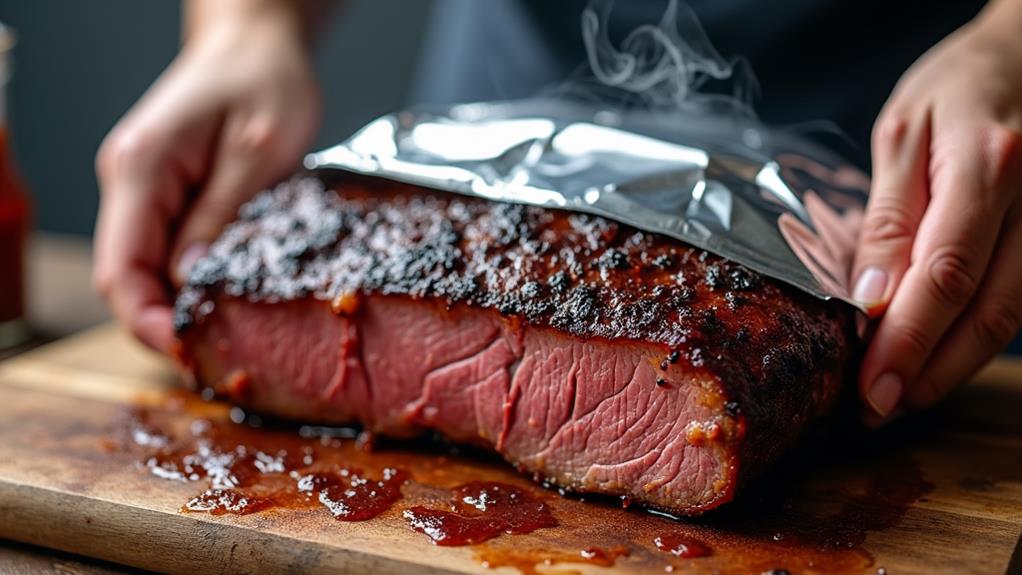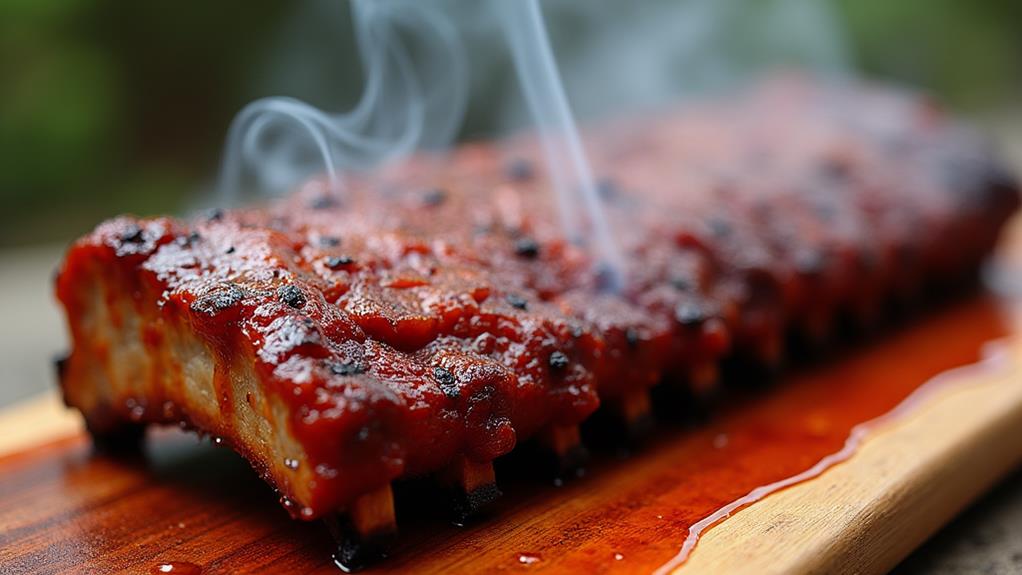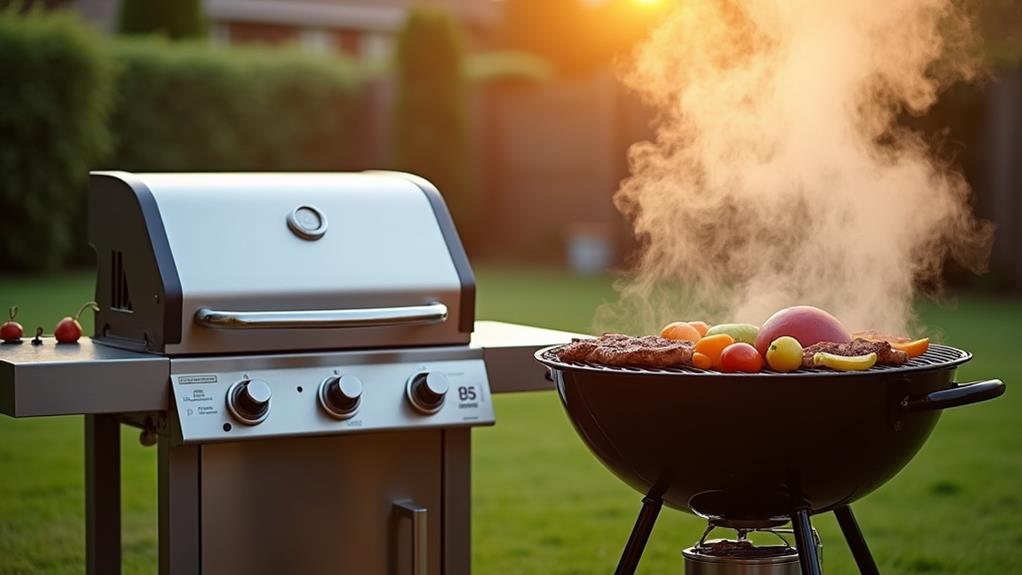To achieve succulent slow-cooked barbecue perfection, start by selecting prime cuts like brisket or pork shoulder. Master temperature control, maintaining a steady 225°F to 250°F for optimal results. Experiment with different wood types to create unique flavor profiles, and use high-quality temperature probes for accuracy. Enhance flavor with brines and rubs, letting them penetrate the meat overnight. Perfect the Texas Crutch technique by wrapping meat in foil to retain moisture. When serving, slice against the grain and present on rustic platters with a variety of sauces. These techniques will elevate your barbecue game, but there's always more to discover in the world of slow-cooking mastery.
Choosing Prime Cuts for Barbecue
When it comes to barbecue, selecting the right cuts of meat is crucial for achieving mouthwatering results. You'll want to focus on cuts that excel in slow-cooking methods, as these will yield the most tender and flavorful outcomes.
For instance, similar to a delicious Slow Cooker Chili Con Carne that benefits from low-and-slow cooking, understanding the importance of marbling is key; those beautiful streaks of intramuscular fat will melt during cooking, basting the meat from within and creating a succulent texture.
For beef, consider brisket, chuck roast, or short ribs. These cuts have ample marbling and connective tissue that break down beautifully over low, slow heat.
Pork enthusiasts should look for shoulder (also known as Boston butt) or spare ribs, both of which offer excellent fat distribution. If you're into poultry, opt for bone-in, skin-on chicken thighs or whole birds for maximum flavor.
Don't overlook the potential of less common cuts like beef plate ribs or pork belly. These often-overlooked options can produce spectacular results when handled correctly.
Temperature Control Mastery
Now that you've selected the perfect cuts, mastering temperature control is your next challenge. To achieve barbecue perfection, you'll need to embrace innovative techniques that ensure consistent heat throughout the cooking process.
Start by investing in high-quality temperature probes, which will allow you to monitor your meat's internal temperature without lifting the lid and releasing precious heat.
Understanding the relationship between cooking times and temperature is crucial. For optimal results, maintain a steady temperature between 225°F and 250°F. This low and slow approach allows the connective tissues to break down gradually, resulting in tender, juicy meat.
To achieve this, you'll need to master your grill's vents and dampers. Open them to increase airflow and raise the temperature, or close them to reduce heat.
Don't be afraid to experiment with different fuel combinations to fine-tune your temperature control. Mixing wood chunks with charcoal can provide both steady heat and smoky flavor.
Smoke and Wood Flavor Profiles

When it comes to barbecue, your choice of wood can dramatically influence the flavor profile of your meat.
You'll want to carefully select woods that complement your protein, such as hickory for beef, apple for pork, or mesquite for poultry.
To control smoke intensity, you can adjust the amount of wood used, the size of your wood chunks, and the overall cooking time, allowing you to fine-tune the smoky essence to your preference.
Wood Selection for BBQ
The key to exceptional barbecue lies in the wood you choose. Different wood types impart unique flavors, enhancing your meat's taste profile in distinct ways. To revolutionize your BBQ game, you'll need to understand how each wood variety interacts with your chosen cuts.
For a classic, mild smokiness, opt for hickory or oak. These versatile woods complement most meats without overpowering them.
If you're looking to push boundaries, try fruit woods like apple or cherry for a subtly sweet finish that pairs beautifully with pork and poultry. For a bolder flavor enhancement, mesquite delivers an intense, earthy taste that's perfect for beef.
Don't be afraid to experiment with wood combinations. Mixing hickory and applewood, for instance, can create a complex flavor profile that'll elevate your barbecue to new heights.
Remember, the amount of wood you use is just as crucial as the type. Start with small quantities and adjust based on your taste preferences.
Smoke Intensity Control
Mastering smoke intensity is crucial for achieving barbecue perfection. To control smoke levels, you'll need to understand the interplay between wood type, airflow, and temperature. Start by selecting the right wood chips or chunks for your desired flavor profile. Experiment with different combinations to find the perfect balance between smokiness and your meat's natural taste.
To achieve those coveted smoke rings, maintain a consistent low temperature and steady smoke flow. You can regulate smoke intensity by adjusting your smoker's vents or dampers. Opening them wider increases airflow and reduces smoke, while closing them intensifies the smoky flavor.
Remember, too much smoke can overpower your meat, so aim for a thin, blue smoke rather than thick, white billows.
For optimal flavor balance, consider using a two-zone cooking method. This technique allows you to smoke your meat indirectly while having a hotter zone for searing or finishing.
Brines and Rubs Secrets
Many barbecue enthusiasts swear by brines and rubs as the secret weapons for achieving mouthwatering, flavorful meats. These techniques can transform your barbecue game, elevating your dishes to new heights of succulence and taste.
To master brine recipes, start with a basic solution of salt, sugar, and water, then experiment with adding herbs, spices, and aromatics to infuse unique flavors. For poultry and pork, try a citrus-based brine to tenderize and brighten the meat's flavor profile.
When it comes to rub techniques, the key is layering flavors. Begin with a base of salt and sugar, then build complexity by incorporating spices like paprika, garlic powder, and black pepper. For an innovative twist, consider adding coffee grounds or cocoa powder to your rub for a deep, rich flavor.
Apply your rub generously, massaging it into the meat's surface to ensure even coverage. For maximum impact, let the rubbed meat rest in the refrigerator for several hours or overnight before cooking. This allows the flavors to penetrate deeply, resulting in a more intensely flavored final product.
Perfecting the Texas Crutch

Barbecue enthusiasts often turn to the Texas Crutch technique to achieve tender, juicy meats with a perfect bark. This innovative method involves foil wrapping your meat during the cooking process, which can significantly reduce cooking times and enhance moisture retention.
To perfect the Texas Crutch, start by smoking your meat until it reaches an internal temperature of about 165°F (74°C). At this point, wrap the meat tightly in heavy-duty aluminum foil, creating a sealed environment that traps heat and moisture.
You'll want to add a small amount of liquid, such as apple juice or beer, to the foil packet before sealing it. This step helps create steam, which further tenderizes the meat.
Continue cooking the wrapped meat until it reaches your desired internal temperature, typically around 203°F (95°C) for brisket or pork shoulder. The Texas Crutch can shave hours off your cooking time, but be cautious not to leave the meat wrapped for too long, as this may soften the bark.
To finish, unwrap the meat and return it to the smoker for a short period to firm up the exterior.
Presenting Your Smoky Masterpiece
The final step in your barbecue journey is presenting your smoky masterpiece. After hours of careful preparation and cooking, it's time to showcase your culinary creation. Consider innovative serving suggestions that will elevate your barbecue experience.
Slice your meat against the grain to ensure maximum tenderness, and arrange it artfully on a rustic wooden board or a sleek, modern platter. For the perfect finishing touch, drizzle a thin layer of your signature sauce over the top, allowing the meat's natural flavors to shine through, similar to how you'd dress BBQ pulled pork sandwiches with customizable toppings like coleslaw and pickles.
When it comes to side pairings, think beyond traditional coleslaw and baked beans. Experiment with grilled vegetables, such as asparagus or zucchini, to add a fresh, smoky element to your plate. For a unique twist, try serving a bright, citrus-based salad to cut through the richness of the meat.
Don't forget about bread options; warm, crusty artisanal rolls or homemade cornbread can complement your barbecue perfectly. Finally, consider offering a selection of regional sauces, allowing your guests to customize their experience and explore different flavor profiles.
Frequently Asked Questions
How Do I Clean and Maintain My Smoker or Grill?
You'll want to invest in quality smoker accessories for optimal maintenance. Regularly brush and scrape your grill, regardless of type. Clean ash and grease after each use. Protect your smoker from the elements with a cover when not in use.
What's the Best Way to Store Leftover Barbecue?
You've savored the feast, now conquer leftovers! Store your barbecue gold in airtight containers, refrigerating for short-term or freezing for long-term preservation. When reheating, innovate with steam or sous vide methods to maintain that succulent texture you worked so hard for.
Can I Use a Gas Grill for Authentic Barbecue?
You can achieve authentic flavors with a gas grill. Get creative with wood chips, smoker boxes, and indirect heat techniques. It's not traditional, but with innovative gas grill techniques, you'll impress even barbecue purists. Experiment and make it your own!
How Do I Prevent My Barbecue From Drying Out During Long Cooks?
Imagine your brisket turning into leather. To prevent this, focus on moisture retention. You'll want to use innovative cooking techniques like wrapping in butcher paper, spritzing regularly, or using a water pan. These methods ensure your barbecue stays juicy.
What Are the Safety Precautions When Handling Hot Barbecue Equipment?
You'll want to prioritize barbecue safety by using heat-resistant gloves and long-handled tools. Don't forget to keep a fire extinguisher nearby. Stay alert and avoid loose clothing. Always clean and maintain your equipment for optimal performance.
Final Thoughts
You've mastered the art of slow-cooked barbecue, balancing patience with precision. While your neighbors might be rushing their grills, you're crafting smoky perfection. Remember, great barbecue isn't just about the meat; it's a symphony of flavors, techniques, and timing. From selecting prime cuts to presenting your masterpiece, you've learned to orchestrate every step. Now, armed with these secrets, you're ready to elevate your backyard cookouts from ordinary to extraordinary. Fire up that smoker and let your culinary prowess shine!















